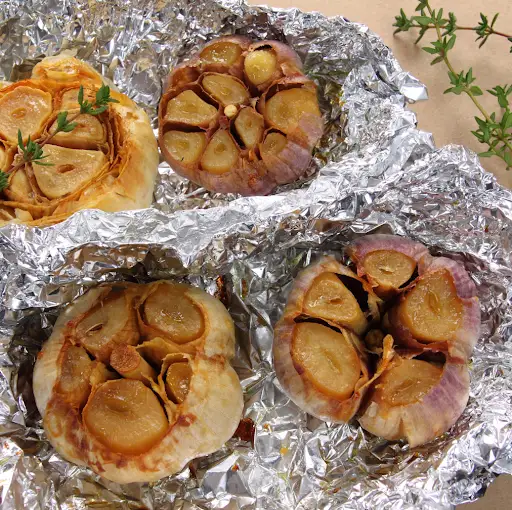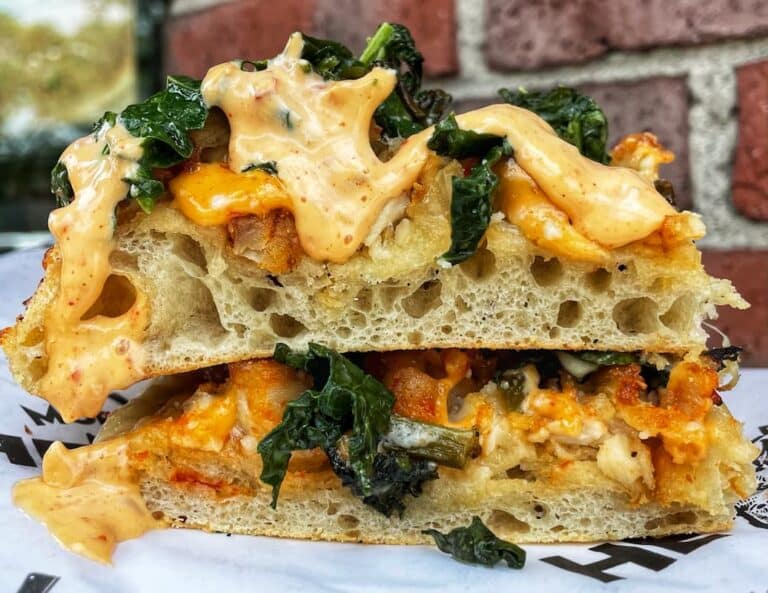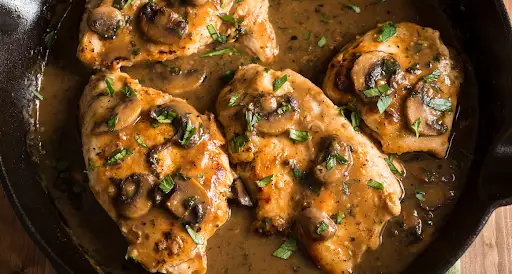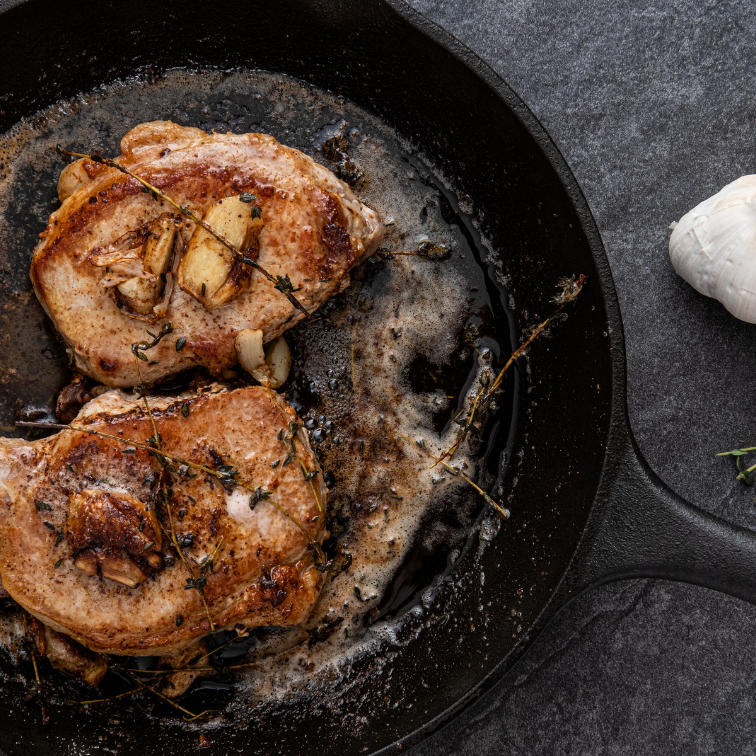If you’re Italian, it’s in your blood to love garlic. Aglio, if you speak the language.
Garlic lovers know that the more garlic, the better. In fact, when we cook at home, we often use double the amount of garlic called for in a recipe. No shame in this cooking game.
You can always find whole heads of garlic or fresh garlic in an Italian kitchen, but you won’t often find pre-peeled garlic cloves. We like unpeeled garlic cloves for the most flavor.
While most recipes use raw garlic, having roasted garlic on hand is essential in the Italian kitchen.
Roasted cloves are an easy way to add extra flavor to pasta dishes, salad dressings, pasta sauces, pizzas, garlic bread, crusty bread, and one of our favorite recipes, baba ganoush.
Roasting changes the chemical makeup of the garlic so that it’s easier to digest. This means you get to eat a lot more of it. It’s extremely versatile and so simple to make, so head to the grocery store, heat up that oven, and get those bulbs ready.
While there are many different methods, read on to learn about our favorite way to roast garlic.

Ingredients Needed For Roasted Garlic
- 1 whole head of garlic
- Kosher salt
- Olive oil
How To Roast Garlic
- Preheat oven to 400 degrees F. The high heat is the best way for browning.
- Peel just the papery skin of the top of the garlic bulb, leaving the individual cloves intact.
- Using a sharp knife, cut ¼ to ½-inch from the top of the head to expose the individual cloves of garlic.
- Place the whole cut bulb cut side up on a baking sheet or small baking dish that has been lined with a piece of parchment paper. A muffin tin works well here too.
- Drizzle high-quality Italian olive oil over the garlic, making sure to use enough olive oil to cover the whole head. Use your fingers to rub a little oil all over the exposed cloves.
- Cover garlic with a piece of foil, loosely folding tin foil at the top. Bake for 30-35 minutes or until cloves feel soft and are golden brown.
- Remove from oven and let garlic cool. Carefully cut the skin around each clove. Use your fingers to squeeze or pull out the roasted garlic cloves from the skin.
Store your golden brown in an airtight container or any sealed container. If you won’t be using all of your oven-roasted garlic over the next few days, you can use an ice cube tray or freezer-safe container as a simple method for storing.
Ways To Use Your Roasted Garlic
- Eat as is or save the garlic paste for future use
- Top salads with individual cloves
- Make garlic toast
- Add to mashed potatoes
- Spread over warm toasted bread with tomato, basil, and olive oil
- Spread on pizza dough in place of traditional tomato sauce
- Toss into warm pasta with parmesan cheese, olive oil, and freshly cracked pepper
- Sauté with greens: Swiss chard, broccoli rabe, etc.
Health Benefits of Roasted Garlic
Roasted garlic is not just a flavor-packed ingredient; it also boasts a multitude of health benefits. Its nutritional profile is similar to raw garlic but has a milder taste, making it easier to incorporate into a variety of dishes. Here’s a look at some of the advantages of including roasted garlic in your diet:
Boosts Immune System
- Antibacterial and Antiviral Properties: Garlic contains compounds like allicin that have been shown to help fight bacteria and viruses, potentially boosting your immune system.
Heart Health
- Lowers Cholesterol: Regular consumption of garlic has been linked to lower levels of LDL cholesterol, often termed as ‘bad’ cholesterol.
- Improves Blood Flow: Garlic helps dilate blood vessels and improve circulation, which can aid in lowering blood pressure.
Antioxidant Benefits
- Neutralizes Free Radicals: Garlic is rich in antioxidants that help combat oxidative stress, a contributing factor in aging and various diseases.
Anti-Inflammatory
- Reduces Inflammation: Compounds in garlic have anti-inflammatory effects, which can be beneficial for individuals with inflammatory conditions like arthritis.
Digestive Health
- Aids Digestion: Garlic promotes healthy digestion and can help alleviate various digestive issues, such as bloating and indigestion.
Cancer Prevention
- Protective Compounds: Some studies suggest that garlic consumption may be linked to a reduced risk of certain types of cancer, thanks to its antioxidant and anti-inflammatory properties.
Diabetes Management
- Blood Sugar Control: Garlic has been shown to help regulate blood sugar levels, which can be beneficial for individuals managing diabetes.
Nutrient-Rich
- Vitamins and Minerals: Garlic is a good source of nutrients like Vitamin C, Vitamin B6, and manganese.
Skin Health
- Anti-Acne: The antimicrobial properties of garlic can help fight acne-causing bacteria when used topically, although caution should be exercised due to the potential for skin irritation.
Roasted Garlic Recipe Tips and Tricks
Roasting garlic is an incredibly simple yet rewarding culinary endeavor. However, there are ways to elevate this already divine ingredient to sublime heights. Here are some tips and tricks to help you make the most of your roasted garlic adventure.
Quality of Garlic
- Choose Fresh Garlic: Always select fresh garlic bulbs with firm, tight cloves. Avoid bulbs that are soft, moldy, or sprouting.
Oven Temperature
- Preheat the Oven: Always preheat your oven to ensure even cooking.
- Temperature Matters: The common temperature range for roasting garlic is between 375°F to 400°F (190°C to 205°C). Lower temperatures may result in uneven roasting, while higher temperatures might burn the garlic.
Cooking Time
- Check Doneness: Roasting time can vary based on the size of the garlic cloves and your specific oven. It’s generally ready when the cloves are soft, golden, and slightly caramelized. Checking at intervals can prevent burning.
Preparation Hacks
- Slice the Top Off: Be sure to slice off just enough of the top to expose the individual garlic cloves. This makes it easier for the garlic to absorb any added flavors and for you to extract the cloves later.
- Season Generously: Don’t skimp on olive oil, salt, and any additional herbs you might want to use. These seasonings help draw out the natural flavors of the garlic.
Advanced Flavoring
- Herb Infusion: Consider adding herbs like rosemary or thyme to the olive oil before drizzling it over the garlic.
- Spice it Up: For a different flavor profile, add a sprinkle of red pepper flakes before roasting.
Storage Tips
- Freezing: Roasted garlic can be frozen for later use. Simply place individual cloves in an ice cube tray, cover with olive oil, and freeze.
- Refrigeration: Store in an airtight container covered in olive oil for up to two weeks in the fridge.
Multi-Tasking
- Roast in Bulk: If you’re already using the oven for another dish, toss in a bulb or two of garlic. You can never have too much roasted garlic on hand!
What To Serve with Roasted Garlic
Roasted garlic is an incredibly versatile ingredient that can elevate a wide range of dishes. Its sweet, mellow flavor and creamy texture make it a culinary powerhouse, whether used as a spread, a base for sauces, or a garnish. Here are some ideas for what to serve with your roasted garlic:
Breads and Crackers
- Baguette: Sliced and toasted baguette makes an excellent vehicle for roasted garlic. Simply spread the creamy cloves like butter and enjoy.
- Crackers: For a quick and easy snack, pair roasted garlic with whole-grain crackers.
Meats and Seafood
- Steak: Incorporate roasted garlic into a herb butter to melt over a perfectly cooked steak.
- Chicken: Stuff roasted garlic under the skin before roasting for an extra layer of flavor.
- Fish: Add roasted garlic to a marinade or use it to season grilled or baked fish.
Vegetables
- Roasted Vegetables: Toss your choice of vegetables in olive oil, salt, and roasted garlic before roasting for a flavor-packed side dish.
- Mashed Potatoes: Stir some roasted garlic into your mashed potatoes for a gourmet twist on a classic dish.
Soups and Sauces
- Tomato Soup: A few cloves of roasted garlic blended into a homemade tomato soup can provide a depth of flavor.
- Alfredo Sauce: Incorporate roasted garlic into a creamy Alfredo sauce for a rich, nuanced taste.
Pasta and Grains
- Garlic Pasta: Mix roasted garlic with olive oil and your choice of herbs for a simple yet luxurious pasta sauce.
- Risotto: Stir in some roasted garlic cloves when making a Parmesan risotto to enhance its flavor profile.
Salads
- Caesar Salad: Blend a clove or two into your homemade Caesar dressing for an extra kick.
- Coleslaw: Spice up a traditional coleslaw recipe by adding some minced roasted garlic to the dressing.
Beverages
- Wine: A white wine like Chardonnay or a light red like Pinot Noir can complement the sweet, nutty flavor of roasted garlic.
- Beer: If you prefer beer, go for something light and crisp, like a pilsner or a lager, to balance out the richness of the garlic.
Desserts
Although unconventional, a small amount of roasted garlic can be blended into savory dessert options like a garlic-infused olive oil ice cream or a roasted garlic and goat cheese cheesecake.
PrintEasy Roasted Garlic Recipe
5 Stars 4 Stars 3 Stars 2 Stars 1 Star
No reviews
- Author: Mortadella Head
Ingredients
- 1 whole head of garlic
- Kosher salt
- Olive oil
Instructions
- Preheat oven to 400 degrees F. The high heat is the best way for browning.
- Peel just the papery skin of the top of the garlic bulb, leaving the individual cloves intact.
- Using a sharp knife, cut ¼ to ½-inch from the top of the head to expose the individual cloves of garlic.
- Place the whole cut bulb cut side up on a baking sheet or small baking dish that has been lined with a piece of parchment paper. A muffin tin works well here too.
- Drizzle high-quality Italian olive oil over the garlic, making sure to use enough olive oil to cover the whole head. Use your fingers to rub a little oil all over the exposed cloves.
- Cover garlic with a piece of foil, loosely folding tin foil at the top. Bake for 30-35 minutes or until cloves feel soft and are golden brown.
- Remove from oven and let garlic cool. Carefully cut the skin around each clove. Use your fingers to squeeze or pull out the roasted garlic cloves from the skin.
Store your golden brown in an airtight container or any sealed container. If you won’t be using all of your oven-roasted garlic over the next few days, you can use an ice cube tray or freezer-safe container as a simple method for storing.










